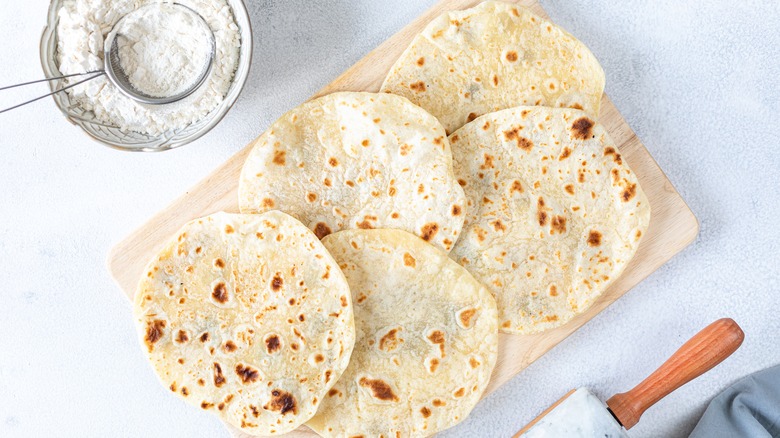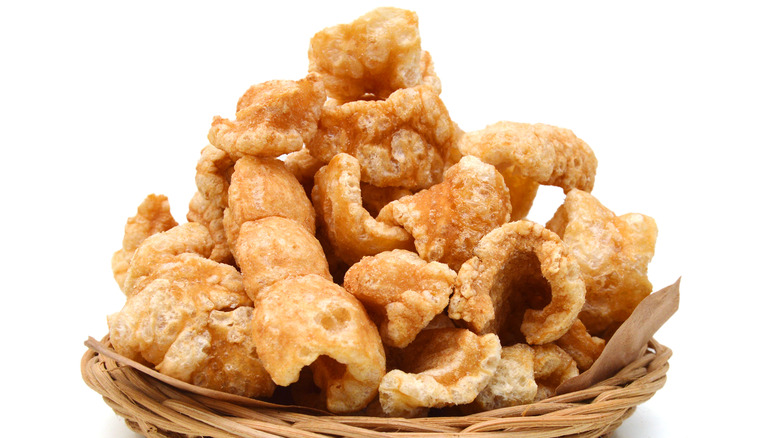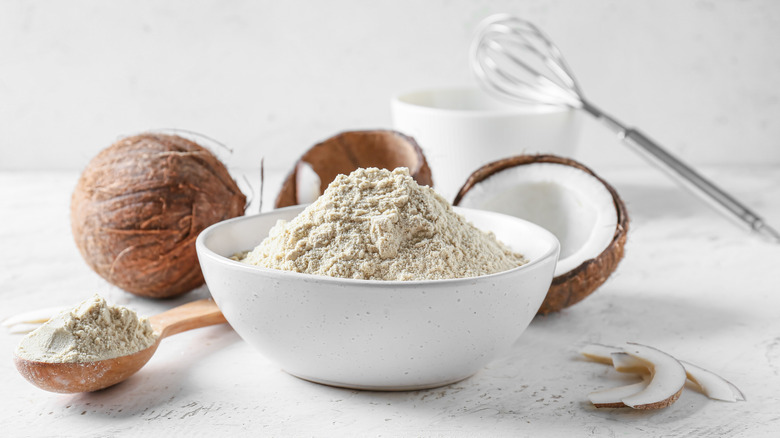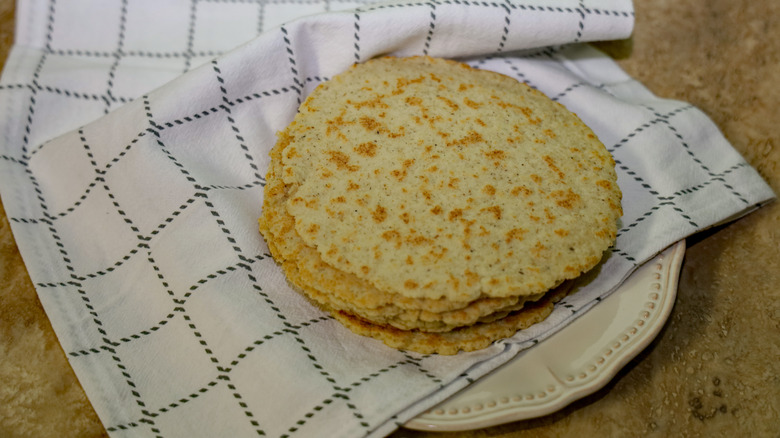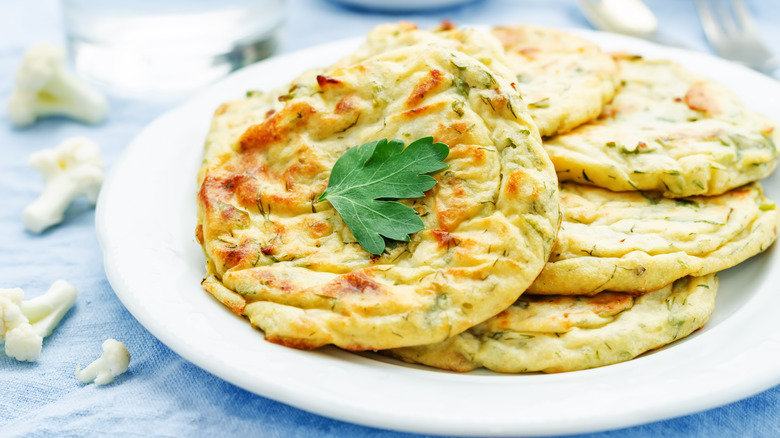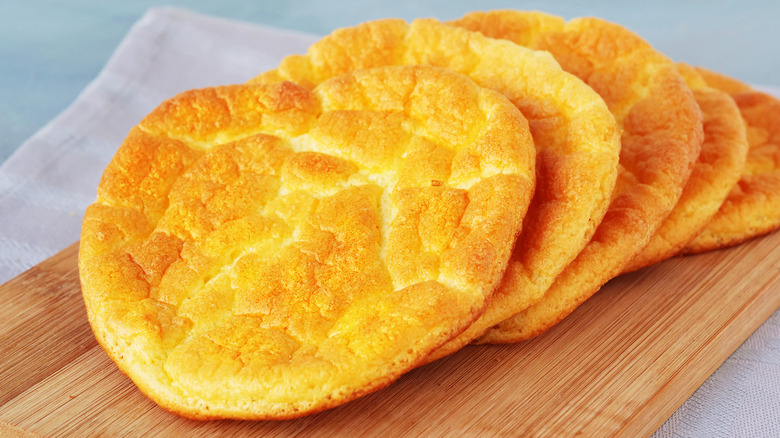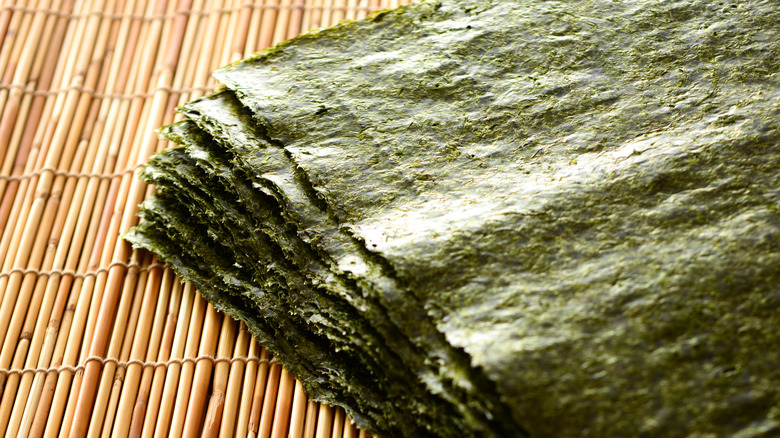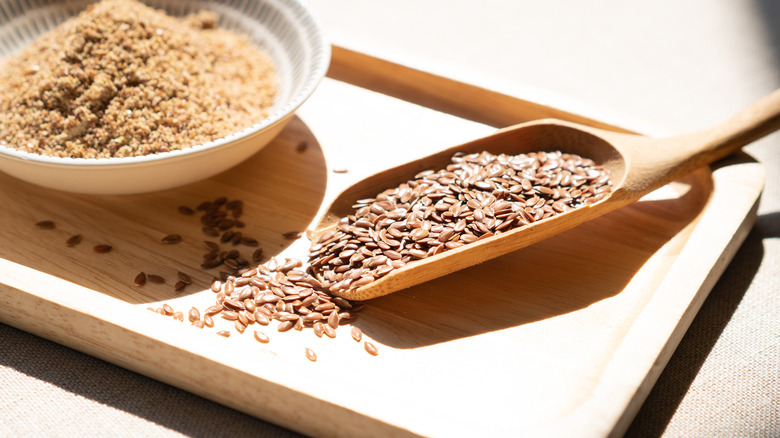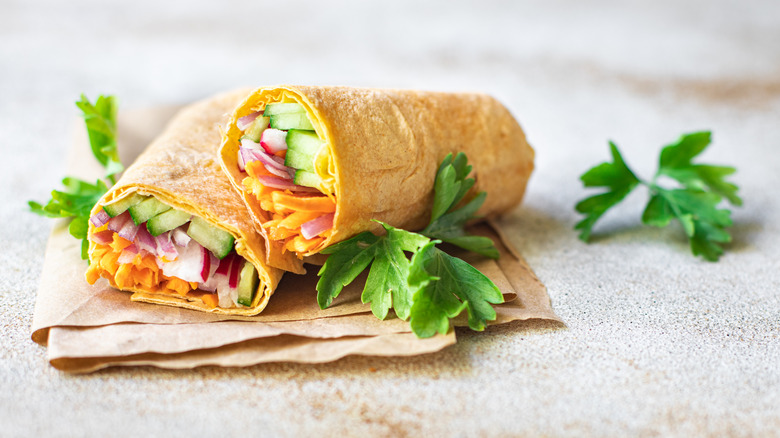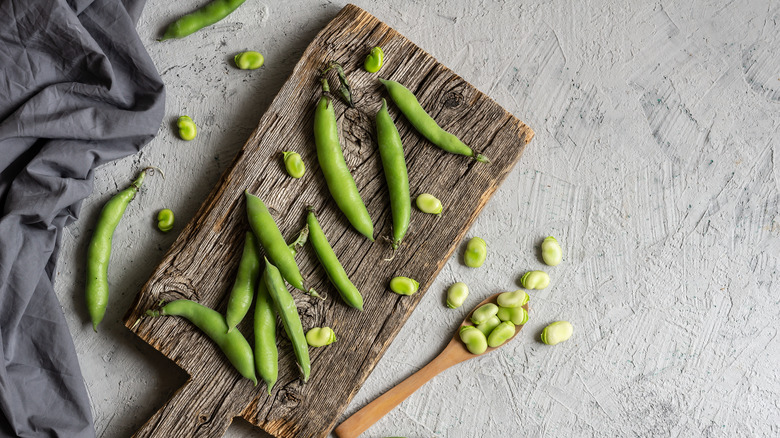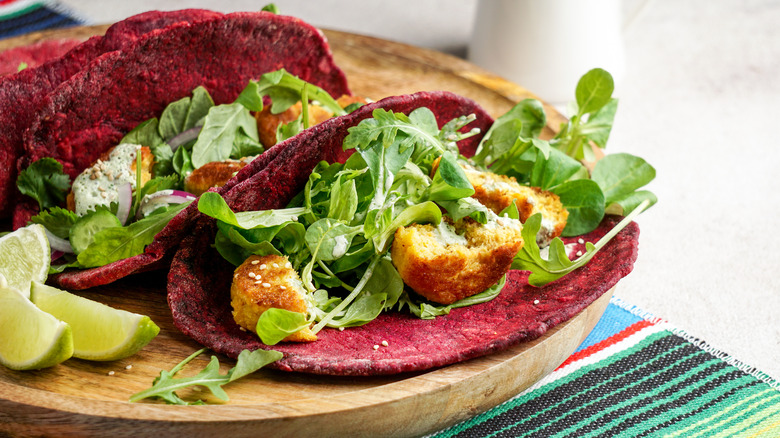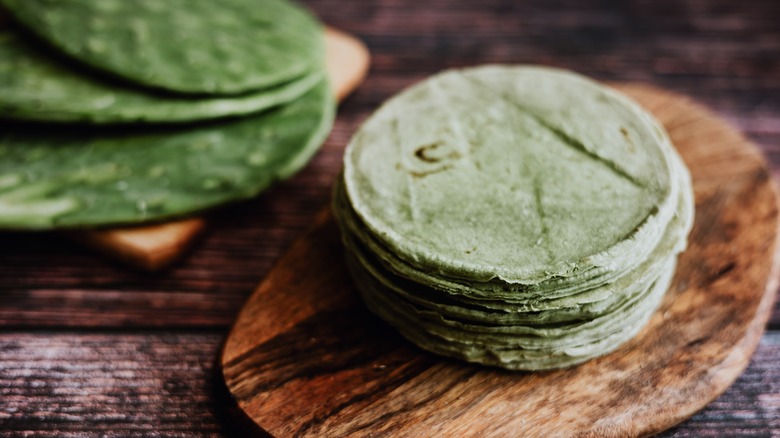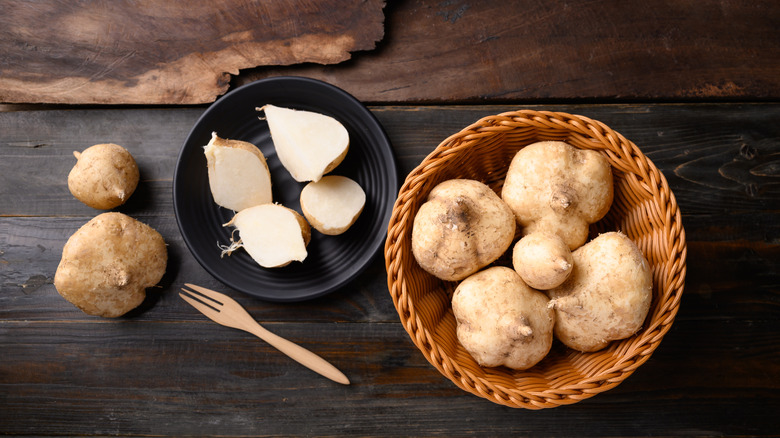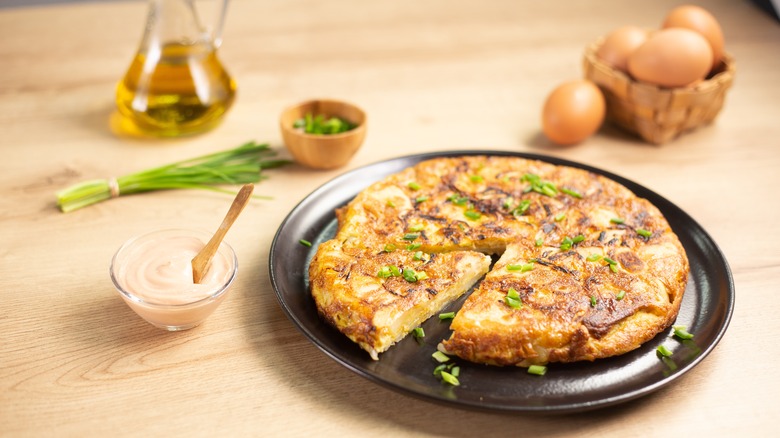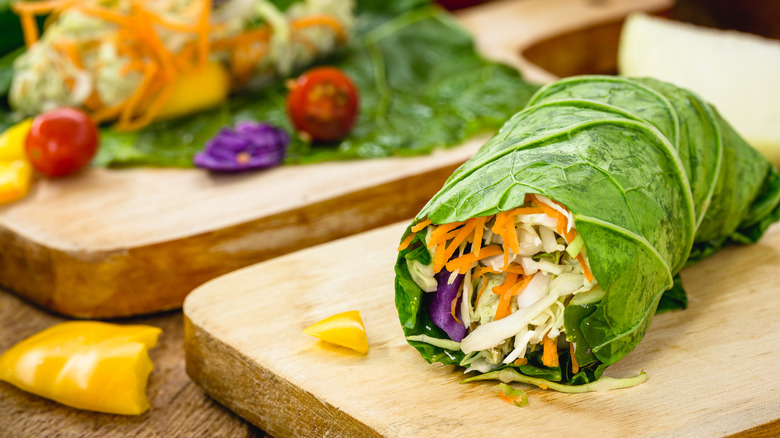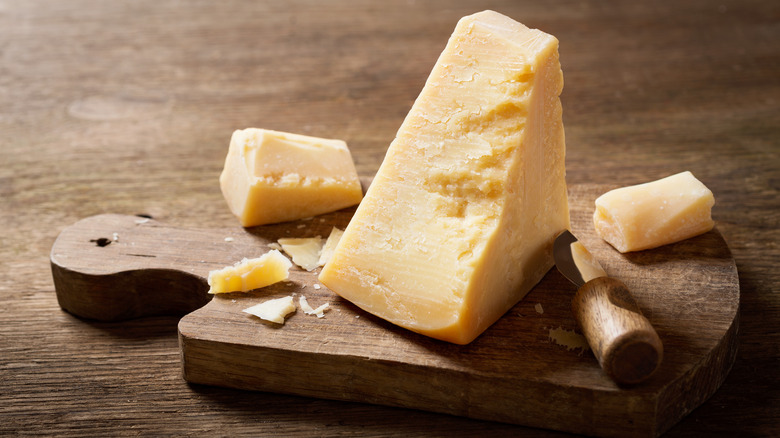The Best Keto Alternatives For Tortillas
We may receive a commission on purchases made from links.
According to American Fitness Professionals & Associates (AFPA), the keto diet initially developed when physicians began studying it to treat epilepsy. The first case study took place in France in 1911, but it wasn't until the 1990s that the keto diet gained more traction due to an episode of Dateline. The episode that aired in October 1994 highlighted the story of a little boy named Charlie who was put on the diet to help reduce his seizures — inspiring many to research and try it for themselves. Now, the search for keto alternatives to tortillas, bread, and other popular carb-heavy foods is a common quest.
Healthline explains that the term keto is short for ketosis, which is the name of the process of body fat being burned for fuel. The average person's body is usually burning glucose instead since most of the food we eat contains many carbs. Eating low-carb food is the key to mastering the keto diet as the central tenants of keto recommend having no more than 50 total grams of carbohydrates each day.
Losing weight might be difficult while experiencing food cravings for (delicious) higher-carb foods such as tacos, burritos, and wraps. Corn and flour tortillas alone are exceedingly high in carbs that are not beneficial for your health. Fortunately, eating a taco will no longer be impossible when on a keto diet, thanks to these alternative tortilla ideas.
Pork rind tortillas
Pork rinds are pieces of fried pork skin that are commonly enjoyed as a snack. You can either cook them or buy them at most grocery stores. The USDA Nutrient Database reports that pork rinds don't have any carbs, which are perfect for a low-carb diet. Conveniently, pork rinds can have a similar consistency to flour if you grind them up. The most efficient way to do so is by using a food processor, which will crush the pork rinds into having a flour-like consistency. This is a perfect substitute for those who preferred to use flour tortillas before switching to the keto diet.
The ground pork rinds will develop an even closer texture to flour tortillas by mixing them with eggs, water, and a slight amount of seasoning to form a dough. You can then separate them into balls and flatten them to make a recognizable tortilla shape. Choose your oil wisely when cooking these tortilla shells, as many cooking oils out there aren't keto-friendly. Some of the best oils to use when making keto tortillas are avocado and coconut oil, which are high in fat and low in carbs, per Healthline.
Coconut flour tortillas
Coconut flour is a great option when baking most sweet treats like muffins and cookies. It's also just as useful for curries, soups, and bread. Coconut flour is especially useful for tortillas when you're on a keto diet and want to use alternatives for wheat flour.
The way coconut flour is processed aids in reducing its fat in comparison to many other types of flour in which the amount of fat will remain unchanged. Healthline explains that an ounce of coconut flour contains 18 grams of carbs. This may seem rather high for keto dieters, but that number will spread out once you mix it with a large amount of water and eggs. Because coconut flour is excessively absorbent, there's no need to use more than ¼ cup to make your tortillas. If there are any noticeable lumps in your coconut flour, use a sieve to disintegrate them. You'll then be left with a bowl of smooth coconut flour that you can form into tortilla disks.
Coconut on its own provides many benefits for keto dieters in particular, and for overall nutrition. This superfood has water high in electrolytes, which Cleveland Clinic says helps people balance fluids outside and within their cells. If you consider the combination of slightly sweet and mildly wholesome to be a power couple, coconut tortillas will take your and your keto diet on a double date.
Almond flour tortillas
Almond flour is another type of flour that's great for making tortillas keto-friendly and which Healthline notes is considered a popular alternative for wheat flour. Perhaps this is because a single ounce of almond flour has four grams of net carbs (5.6 grams of carbs in total), three grams of fiber, six grams of protein, and 14 to 15 grams of fat. (Net carbs refer to the ones you will be able to fully digest and burn for energy, notes Medical News Today.) Almond flour may have more fat than wheat flour, but it contains several nutritional benefits that might make you ditch wheat flour altogether.
Almond flour includes a high amount of magnesium which manages your blood sugar levels. This is a great factor to consider if you have type 2 diabetes. It's especially useful since keto-friendly flour delivers a low glycemic index, keeping the body slowly energized for a longer time. Almond flour is better than coconut flour in terms of nutritional value because it has less phytic acid, which allows the human body to take in more nutrients. Almond flour is also gluten-free, so if you are on a keto diet and have celiac disease or a form of gluten intolerance, this is the tortilla alternative for you.
Cauliflower tortillas
Not all vegetable-based tortillas are good for the keto diet. Thankfully, cauliflower is one of the good ones, either as a keto side dish for your next dinner party or as a replacement for flour in tortillas. It has a great low-carb profile, and a cup of cauliflower carries three grams of carbs, according to the USDA Nutrient Database. This vegetable may not be everyone's favorite due to its bland taste, but to be fair — tortillas don't have a prominent flavor either. Putting these two together creates keto-friendly food that will go well with other low-carb ingredients that can pack more flavor.
Cauliflower tortillas are the whole package as this concoction is gluten, grain, and nut-free — an exceedingly accessible option for not only keto-dieters but many people with food sensitivities. It's important to note that the amount of carbs per serving depends on the size of the tortilla. If you are extremely cautious about how many carbs you want to include in your meals daily, it might be best to refrain from making larger tortilla shells. Additionally, Sure Keto recommends it as a better step to make homemade cauliflower tortillas since many store-brand versions — such as Caulipower and La Tortilla Factory — contain 40 to 50 net carbs.
Oopsie bread
Now you're probably wondering — what on Earth is oopsie bread, and why would anyone name a food that? As you can guess, the bread's name references how it was made by accident. Cloud bread (the original version of oopsie bread) has been known as a bread alternative since the development of the Atkins Diet. But, it regained popularity in 2020 when a viral video of a TikTok recipe received over 20 million views, according to Matador Network. Cloud bread isn't keto-friendly, but it can become a part of your keto diet if you replace the correct ingredients.
Cloud bread is a type of bread that contains egg whites, cornstarch, and sugar. Out of all the items included in this list, egg white is the only one you should keep. You can kill two of the ingredients with one stone — the stone being xanthan gum, which is made from fermented sugar and is one of the best keto alternatives for cornstarch. Xanthan gum has zero net carbs and can also be used as an egg replacement if you're a vegan and on a keto diet.
Since cloud bread doesn't need wheat flour, keto substitutes such as coconut or almond flour are also not necessary to make the recipe for oopsie bread. Keto taco-cravers can create a tortilla-like keto alternative to stuff full of savory ingredients by rolling your oopsie dough out flat.
Nori sheets
Nori is the whole package when it comes to a keto diet — it's low in calories, carbs, and fats. Sure Keto explains that if you serve 10 grams of nori, it will only include 0.5 grams of net carbs.
Since nori has such a small amount of carbs and fats, it's beneficial to use it as an addition to the dish you create as long as the other ingredients also have low carbs and more fats in comparison. The keto diet helps you burn fat instead of glucose, so you'll need to incorporate a sustainable amount of foods with healthy fats to keep you energized, full, and nourished throughout the day. Some examples of keto-friendly oils that contain healthy fats and go well with nori sheets are virgin olive oil and MCT (Medium-Chain Triglycerides) oil. The way nori is processed is also helpful as it's protected from oils, sweeteners, and other food additions that aren't keto-friendly. Blue Dragon's nori sheets are a strong example of this.
Nori sheets have a faint salty taste that blends well with other ingredients. Incorporating tofu and some slices of cabbage will make your wrap delicious while continuing to be keto-friendly. If this sounds like a good meal, make sure to drizzle some water on the edges of the nori sheets before you wrap everything up. Moisture is needed to keep the sheets glued together since they're naturally dry.
Flax & quinoa wraps
Wraps with non-GMO ingredients are the way to go. La Tortilla Factory specifically has quinoa flax wraps that only include five grams of net carbs and several other benefits. The flaxseeds within the wraps are a great source of fiber and help improve your digestion, according to Mayo Clinic. Quinoa also provides fiber, and its low glycemic index helps stabilize your blood sugar, making it a good option for those with diabetes (via Diabetes Canada).
The Low-Carb High Fiber Quinoa and Flax tortillas do contain wheat, which can be problematic for the keto diet due to its inherently higher amount of carbs. However, it's not impossible to eat food products with wheat in them as long as the number of carbs is relatively low, such as how these quinoa and flax wraps are. The tortilla shells also provide a texture that's reminiscent of the traditional flour styles. Do you want to add a grainy and slightly nutty flavor to your next keto taco or wrap? Flaxseeds and quinoa will be the perfect alternatives for you. If wheat is a dealbreaker for your keto diet, you should avoid La Tortilla Factory's wraps and consider making your own from a mix of quinoa and flax seed flour.
Keto pita bread
Pita bread can be relatively high in carbs which wouldn't be good for your keto diet. On another note, you can buy or make a keto version of pita bread which can be helpful to use as a keto-friendly tortilla. Carb Manager explains that the average pita bread is created with white flour, which results in it having 28 grams of net carbs out of 29 carbs in total, while keto-friendly pita bread has four grams of net carbs out of 10 total.
Keto pita bread also includes a range of keto-friendly ingredients that are great to use for any kind of tortillas you want to make or use for your dishes. Almond and coconut flour helps reduce pita bread net count from 28 to approximately four carbohydrates per serving. Psyllium husk is also a great alternative that keto bakers can add to their pita bread recipe instead of wheat flour, as it doesn't contain fat, reduces cravings, and stabilizes blood sugar levels. Ground flax can be just as useful for making keto pita bread as it is for forming wraps with a flaxseed base. It can also be used as an ingredient in flour replacements.
Fava bean wrap
For thousands of years, fava (or faba) beans have been praised as a legendary food for helping people maintain nutritious diets. In New Zealand, companies like Gerry's stake its claim as the first keto-friendly wraps to be made with a base of fava bean, providing high protein along with a low quantity of carbs. In fact, Gerry's contain only 4.2 grams of carbs per wrap. While they aren't commercially available in the U.S., the internet is full of recipes to make your fava bean keto tortilla alternatives. They'll start with dried fava flour.
Fava bean wrap is packed with several vitamins, minerals, and protein. Thanks to a load of dietary fiber, it will also satisfy your hunger for a lengthy period, which other keto-friendly foods might be unable to do (especially if you're new to the low-carb ketosis process). These wraps are also very versatile in helping make many tortilla-based dishes keto-friendly, as the texture can hold up to use for tacos, burritos, quesadillas, enchiladas, chimichangas, and even tortilla chips — something not every keto tortilla alternative can accomplish. In fact, research from the Emirates Journal of Food and Agriculture already suggests that fava bean flour is useful when enriching corn tortillas, so it's only a matter of time before they enter your local grocery.
Beet wraps
Do you want to use tortilla shells that are both beautiful and healthy? Options such as beet wraps from Angelic Bakehouse can satisfy multiple needs at once. These reddish tortillas are flavored with beet juice and are accessible to those who are lactose-intolerant, vegan, and allergic to nuts.
On another note, you should be cautious about beets and any food they're a part of because Medical News Today notes that a single cup of raw beets includes 13 grams of carbs. Although the beet wraps contain whole wheat flour and have more net carbs than other keto alternatives, they're still nutritious. However, it does require more attention to your macronutrient counts in order to include them within your meals. Naturally, this extra planning step may not be ideal. Still, each tortilla you use will only have two grams of fat and sugar. Beets don't require additional sugar as it's inherently sweet with an earthy taste.
The naturally red vegetable may not be the most recommended ingredient for your keto diet, but you don't have to avoid it entirely. Using less than one cup of beets or making a dish with a single beet tortilla should be fine on any given day. Just make sure to pay attention to the nutrition facts and manage accordingly if you're concerned about breaking the diet.
Nopal cactus tortillas
Yes — cactus can be used to make tortillas, particularly keto-friendly ones. This kind of tortilla is considered to be a Mexican delicacy as well. According to Yahoo Finance, a nopal cactus (also known as a prickly pear cactus) tortilla can range from three to 11 carbs and a scale from 20 to 60 calories. Tia Lupita's nopal tortillas are a perfect example of this, as each shell contains only four net carbs.
Cactus, on its own, has a small number of calories and carbs. Using the prickly pear cactus will help your tortillas have a texture that's rather similar to corn tortillas. Nopal cactus has a light astringent flavor, similar to okra but with a touch more citrus accent.
Nopal cactus tortillas can also be used as a great alternative for tortilla chips if you use sea salt for baking them or fry them to create a crispy, tostada-like texture. Just make sure to avoid using canola oil when cooking, or you will break your keto diet. Eating cactus tortillas is no different from your average tortillas — except they're keto-friendly, of course, and have a faint tartness to them.
Jicama tortillas
Similar to the nopal cactus, jicama is another well-loved ingredient in Mexico. The vegetable works well for the keto diet, especially in tortilla form, like those from the brand eaturXica, which contain only 0.7 grams of net carbs per serving (via Whole Foods). Jicama has been described as very similar to turnips, which is another keto-friendly vegetable. Both jicama and turnips are root vegetables with a sweet and nutty flavor. With that being said, ingredients that contrast the sweetness of jicama are the ones that are best included in your next wrap.
Lime juice is a popular and keto-friendly choice often included in most dishes that include jicama. However, it's important to note that just because something doesn't inherently break your keto diet doesn't mean you shouldn't measure your ingredients. Using too much lime juice (or other acidic ingredients) will ruin the purpose of you using the jicama tortillas in the first place. Choosing Nutrition notes that a single lime has five net carbs. If you don't want to risk breaking your diet, stick to using less than one lime on your jicama wraps.
Incorporating jicama tortillas into your diet will give you two victories for the price of one — you get to try a vegetable you've most likely never tasted or even heard about before, and you get to maintain your state of ketosis.
Egg wraps
Eggs are a common ingredient in most recipes for tortillas, and egg whites in particular are a favorite ingredient for most keto-dieters. The reason why egg yolks are often omitted from the keto diet is because of a higher level of cholesterol. Egg-based wraps are vastly keto-friendly as they usually have little to no carbs. Some tortilla alternatives can be difficult for people to use as the taste may not mash well with other ingredients — this is a concern you can throw in your kitchen bin regarding egg wraps. Egg wraps can be flavored with keto-friendly ingredients, including chives, cream cheese, dill, dried rosemary, mint, and much more (as long as the completed wrap is under 30 carbs).
Trader Joe's notes that its popular tortilla wrap alternative contains ever-so-loved egg whites and xanthan gum. The egg wraps also include olive oil, one of the most popular oils used to accompany keto foods. With the slight seasoning of sea salt and white pepper, Trader Joe's egg wraps will not disappoint you in terms of flavor and nutrition.
Lettuce wraps
Sometimes the most effective tortilla to eat on a keto diet is one that's not a tortilla at all. Think of something fresh that doesn't require dough, for instance. Presenting lettuce — one of the most popular green vegetables to eat while on a keto diet. Is it Keto? notes that an entire head of lettuce is nearly 5.6 grams of net carbs — that is a strong indicator that you will have an even smaller intake of carbs by cutting lettuce to make your wraps. A single cup of shredded lettuce includes just over one gram of net carbs.
The keto diet doesn't discriminate against any type of lettuce, as all kinds are keto-friendly. Eating lettuce with a darker shade of green is highly recommended as they contain more nutrients, according to Eat Right. On another note, lettuce with larger leaves, such as butter and romaine, and even lighter green kinds like iceberg lettuce will be easier to use as wraps for your keto-alternative dishes. You may have to trade size for total overall nutrition; however, lettuce is a good keto tortilla option however you look at it.
Parmesan wraps
These wraps are gluten-free, lactose-free, and most importantly — they are mostly carb-free. The Folios Cheese Wrap brand specifically notes that each parmesan shell they sell includes only a single gram of carbs.
The U.S. Department of Agriculture notes that a single tablespoon of parmesan cheese contains 0.7 grams of carbs and 1.4 grams of fat. The tablespoonful of cheese also includes 1.4 grams of protein. Parmesan wraps take the keto diet to the next level as they're 100% made out of cheese. That said, they don't include flour, wheat, sugar, or any other keto-unfriendly ingredients commonly found within recipes for the average tortilla. Keto dieters can utilize parmesan wraps in their dishes in ways most other tortillas and even other keto alternatives for tortillas can't.
Have you ever thought about melting a tortilla shell for a meal? If you haven't, that's because you understand that's impossible, and it doesn't serve any purpose. It's the exact opposite with parmesan wraps. While everyone else is eating their food with a basic tortilla shell, you'll be able to brag about how you could melt yours and show others that you can get creative and have fun while on the keto diet.
